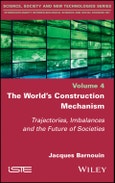The interdisciplinarity between the biological and human sciences is here to serve a daring objective: to decipher, by means of a logical chain, the explanatory factors of human trajectories and imbalances between societies and nations. To do this, The World’s Construction Mechanism is based on an unprecedented analysis of the dynamics of the human species, combining the contributions of anthropology, archeology, biology, climatology, economics, geography, history and sociology.
This book analyzes the roots of societal disharmony and presents ways of realizing a clear-sighted human project that is in step with the general interest of humanity.
Table of Contents
Introduction ix
Chapter 1 History of Color 1
1.1 Linnaeus and us 1
1.2 Ultraviolet and melanin 5
1.3 The skin map 8
1.4 New World Drama 10
1.5 Foundations of an unfounded theory 13
1.6 Deviations in the 19th and 20th Centuries 14
1.7 Symbols and fantasies 20
1.8 Whiteness, blondness and blueness 24
Chapter 2 Geoclimate and Prosperity 27
2.1 Comparisons 27
2.2 More comfortable in the cold than in the heat 35
2.3 Delights of thermal comfort 39
2.4 Temperate life 43
2.5 Time and temperature 45
Chapter 3 Pathway of Societal Precociousness 53
3.1 From climate to history 53
3.2 Original migrations 57
3.3 The corridor effect 60
3.4 On the road to human societies 66
3.5 Obsessive obsidian 71
3.6 From self-service to production control 73
3.7 A crescent… 79
3.8 …fertile in ideas 81
3.9 The emergence of the alphabet 86
Chapter 4 Diffusion of Societal Achievements 91
4.1 The notion of diffusion 91
4.2 Initiation of diffusion 93
4.3 Dynamics of diffusion 99
4.4 From diffusion to prosperity 104
4.5 Other migration and other diffusion 112
4.6 The steppe issue 126
Chapter 5 Cultural Intermission 133
5.1 Taking stock 133
5.2 Tracing culture 135
Chapter 6 Mechanism and Realities 143
6.1 The world’s mechanism 143
6.2 A very important differential 146
6.3 Two sub-species? 155
6.4 What connects the two realities? 158
6.5 Youths 162
Chapter 7 Other Potential Reasons for Societal Imbalances 167
7.1 Inter and intra variation 167
7.2 WCM and income inequality 171
7.3 Factors of income inequality 175
7.4 The creation of inequality 188
7.5 An Asian energy? 194
7.6 Combining equality and prosperity 197
Chapter 8 Three Crucial Questions 201
8.1 A potentially different world? 201
8.2 A potentially devastated world? 203
8.3 Any damage? 209
Chapter 9 Rebalancing Societies 213
9.1 In search of the human project 213
9.2 Two major societal innovations 221
9.3 Containing the WCM 223
9.3.1 Obstacles 223
9.3.2 The educational component 227
9.3.3 The institutional aspect 228
9.4 The future: containment or conflict? 232
9.5 Arrival 234
References 239
Index 271








